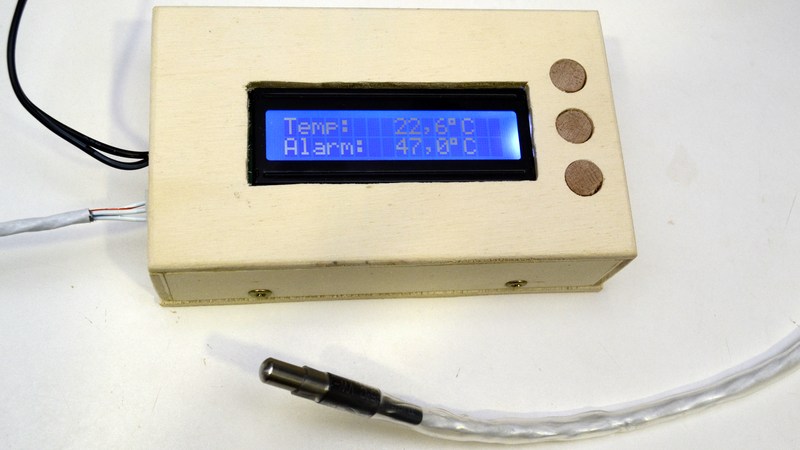Ever have trouble justifying your hacking to anyone from another generation? [Domen] presented his mother with a custom-made device that monitors the milk temperature as it boils on the stove, preventing boil-over. And he made the device robust, simple to use, and foolproof. To his mom, it must look like he’s a wizard — able to conjure up home electronics out of solder smoke and some plywood.
Of course, we know better. Inside his gadget is a simple temperature sensor, an ATtiny841, a very nice home-made PCB, a buzzer, an LCD, and some pushbuttons. [Domen] rubbed together a few pre-existing libraries, and had a working prototype inside a nice wooden box on the quick. It’s a simple hack, but imagine how this must look to a muggle. For the detailed incantations, check out [Domen]’s GitHub for the project.
We especially like the dowel-based button caps and the overall clean and simple aesthetic. It speaks of both the materials on hand and the intended user. [Domen] says that he’s going to add a low-temperature alarm too, which will add a second alarm for when the milk has cooled down enough to add in the cultures that make yogurt — presumably the reason for the boiling milk in the first place. And check out the rivets on the double-sided board. We love that technique here at our home labs.
This project exemplifies one of the reasons that we DIY. It fills a ridiculously niche need, and fills it with style. Try buying that at Walmart!

















Well done for a hack but he probably didn’t need the DS18B20 (he probably had them lying around anyway).
You can use a 1N914 or 1N4148 diode as a temperature sensor. The junction voltage changes with temp.
An ATmega AVR can be configured to use a different reference or multiplier for the Analog reference voltage. I have also seen this done in the Arduino IDE with just some register writes in c.
It’s not extremely accurate like a thermo-couple but useful otherwise.
Just put it mostly ice with a little water and read the 0 degrees point. Then do the same with boiling water for the hundred degrees point. Then you can read the temperature with some *reasonable* accuracy on a linear scale between those two calibration points.
For another reference point in the 35 to 42 degrees c range, you can use a body thermometer. Use lukewarm water or your own body temperature.
Cool project! I built my mother a thermostat for central heated about 12 years ago as it used to be a mechanical one which had a large hysteresis, which makes the temperature swing around the set point too much, being too chilly and too warm several times per day. Mine has an adjustable hysteresis down to 0.3 degrees. It also has a turn on and turn off timer for the morning and night. It still works to this day.
The mechanical ones actually have adjustable hysteresis, it’s a movable wiper on the same pivot the mercury switch and bimetallic strip is on. However, they are supposed to make your furnace run a reasonable length of time per cycle for several reasons, one is, you switch it on twice as often, you wear it out twice as fast, and secondly, it’s like short tripping your car, combustion chamber gets carbed up if it does lots of cold runs and doesn’t get decently hot.
Does the 1N914 or 1N4148 come prepackaged in a stainless steel sealed unit ready for submersion in foodstuff? No? Well sounds like a DS18B20 would be far better suited.
Not all “stainless” steel are created equal, and those cans they place over the sensor barely qualify. They will rust. Also the seal is done with material that is not food safe especially at those temperatures. It’s unlikely to be harmful because of the small amount and I would use it personally because previous exposure to bad ideas has left me not very smart, but one should still be aware of the risks.
Writer links DS18B20 at Adafruit so it’s good chance he used theirs Food-Grade Heat Shrink – https://www.adafruit.com/products/1020
“Usage Temperature Range: -67° to +250° F / -55°C to +120 °C”
And yet still preferable to just dunking an electronic component in milk. Not only for the person but also for the sensor itself.
Well that’s a fair point if you only ever want to measure the temp of food stuffs.
Last time that I had to hack together a temp sensor was because I just started to use toner transfer method and hysteresis of the laminator was too large.
I didn’t have any useful temp sensors around. I did have DS18B20’s but 180 degrees if beyond their specs so I just used a 1c diode as temp regulation was more important than calibration or metrics.
It took me a bit of experimenting before I could get the slush just right.
http://nerdralph.blogspot.ca/2015/11/ds18b20-temperature-sensor-calibration.html
Kudos for the Boys build.
But I wonder that mother Ipavec does not know/have this:
https://en.wikipedia.org/wiki/Milk_watcher
Nice and simple with built in flexibility and feedback.
Is the plastic sleeve lead-free? A lot of plastics use lead for flexibility and leech under high temps. Heavy metal poisoning == not fun.
I have some vague plan that I may get around to one day of hacking our actual oven. With a temp sensor like this for candy/milk/custard/whatever connected to one of the hobs (wireless?) plus decent PID control + notifications on the oven itself. Maybe I will do it if Im ever single again or come into possession of a spare oven lol/